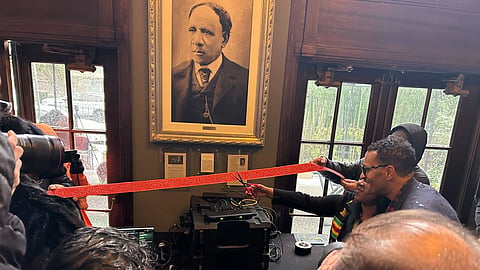The Washington State Black Legacy Institute Opens in West Seattle
On Saturday, Feb. 1, dozens braved the cold to come to the official ribbon cutting ceremony for the Washington State Black Legacy Institute (WSBLI) in West Seattle. Following years of planning and renovation, the organization focused on preserving Washington State's Black history is finally ready to welcome visitors into its permanent location on 42nd Avenue Southwest in West Seattle.
At the opening ceremony, WSBLI CEO and President Kateesha Atterberry spoke about how the project is "standing on the shoulders" of those who came before them. District 1 City Councilmember Rob Saka read an official proclamation from the City of Seattle that declared Feb. 1, 2025, Washington State Black Legacy Institute Day for representing Seattle's values of "cultural preservation, promoting equity, and inspiring future generations to embrace their heritage and leadership potential." WSBLI curator Roger Evans also took to the stage, emphasizing that this place was for everyone.
"This space is your space," he said. "Enjoy it, take care of it."
A sudden flurry of rain and hail forced everyone to quickly duck inside, including Jacqualine Savanna Boles, first lady of Redeemed by the Blood Community Church, as she sang "Swing Low, Sweet Chariot." In the chaos of the moment, WSBLI leaders snipped the red ribbon above the smushed crowd, which cheered, clapped, and whooped during the auspiciously Seattle tenor of the ceremony.
The WSBLI is working with Urban Black, a real estate development firm, to bring the institute's vision to life. According to West Seattle Blog, Urban Black officially purchased the landmarked building — which once served as a Christian Scientist church and then an event venue — last year for $2.75 million. Evans said in an interview with the Emerald last week that the institute will reimburse Urban Black for its investment over time.
Evans has been working on Black heritage preservation in some form over the last 20 years. Evans is a descendant of one of the Black miners who settled in Roslyn, Washington, during the late 19th century, so he says memorializing Washington State Black history has always been deeply personal for him. In the early 2000s, he spent time recording interviews with successful Black figures in the Seattle community. But it was after the 2020 Black Lives Matter protests that he was inspired to create the Seattle Griot Project, a project focused on bringing oral histories of Black communities in King County to the foreground. He interviewed people like activist Eddie Rye, arts advocate Vivian Phillips, Nu Black Arts West actress Kibibi Monie, and Seattle Black Panther Party co-founder Elmer Dixon. The WSBLI is an extension of the Seattle Griot Project's work, making archival work and research more comprehensive.
"[WSBLI] was going to have a place where people can gather stories … like a community hub," said Evans. "We wanted to have a space where we could not only have events, but we could have it decorated and memorialize the efforts of our community."
The Institute's main vestibule is currently displaying giant photo portraits of prominent Black Washingtonians of the past, such as William Grose, one of the wealthiest landowners in 19th-century Seattle; George Washington Bush, one of the earliest Black settlers of the Washington territory; and Nettie Craig Asberry, who founded the Tacoma NAACP branch. As visitors enter the space, they are immediately greeted by these images, a testament to the state's Black cultural legacy.
Downstairs is the main art gallery, where the WSBLI's inaugural exhibition will be up throughout Black History Month. The space includes several works from A Pioneering Spirit: A Fight for Liberty and Freedom, a show by Tacoma-based painter Dionne Bonner of portraits of Black pioneers in the Pacific Northwest. Originally displayed in 1994 as part of the inaugural exhibition at the African American Museum of Tacoma, each portrait is accompanied by information about each Black pioneer. Intermixed are dozens of photographs of Jackson Street during the heydays of the '40s and '50s by legendary Black photographer Al Smith, provided courtesy of the Black Heritage Society.
As for the future, Evans has myriad projects he's eager to dive into. He plans to do more community outreach to bolster the Institute's collection and preservation efforts, build programming based on community camaraderie, offer historical education opportunities for youth interns, and bring other organizations into the space to host events. Even bigger picture, Evans has been working on ways to digitize the collection and mesh it with VR technology and hopes to create a history curriculum with it. This came about after seeing his young granddaughter's skill with smartphones and tablets.
"That provoked me to understand that if I'm going to share history with the next generation, I have to meet them at the level they are learning at," said Evans. He continued, "VR is the next round in understanding and sharing the details of our history," noting that he now films his oral history interviews with a 360 camera to better integrate his work with emerging technology.
For now, WSBLI is focused on getting the building up to speed — it is working on repairing the roof and putting in elevators to make the floors ADA accessible. For its work to really stick, it must be accessible for all in the times to come.
"The space is a symbol to bring your portion of the story to the fullness of Washington State history," Evans offered.
For more information about the Washington State Black Legacy Institute, head over to its website.
Help keep BIPOC-led, community-powered journalism free — become a Rainmaker today.


